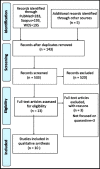Psychological burden of quarantine in children and adolescents: A rapid systematic review and proposed solutions
- PMID: 32704298
- PMCID: PMC7372688
- DOI: 10.12669/pjms.36.5.3088
Psychological burden of quarantine in children and adolescents: A rapid systematic review and proposed solutions
Abstract
As COVID-19 grips the world, many people are quarantined or isolated resulting in adverse consequences for the mental health of youth. This rapid review takes into account the impact of quarantine on mental health of children and adolescents, and proposes measures to improve psychological outcomes of isolation. Three electronic databases including PubMed, Scopus, and ISI Web of Science were searched. Two independent reviewers performed title and abstract screening followed by full-text screening. This review article included 10 studies. The seven studies before onset of COVID 19 about psychological impact of quarantine in children have reported isolation, social exclusion stigma and fear among the children. The most common diagnoses were acute stress disorder, adjustment disorder, grief, and post-traumatic stress disorder. Three studies during the COVID-19 pandemic reported restlessness, irritability, anxiety, clinginess and inattention with increased screen time in children during quarantine. These adverse consequences can be tackled through carefully formulated multilevel interventions.
Keywords: Adolescents; COVID-19; Children; Mental health; Quarantine; Stigma.
Copyright: © Pakistan Journal of Medical Sciences.
Figures
References
-
- WHO. Coming of age:adolescent health. World Health Organization
-
- National Health Commission of the People's Republic of China. Interpretation of Notice on Strengthening the Treatment and Management of Patients with Severe Mental Disorders during the Outbreak of the New Coronary Pneumonia [Internet] Available from: http://www.nhc.gov.cn/jkj/ 3577/202003/a9b0bcb3bb7445298c480c5003c51d6d.... .
-
- Dalton L, Rapa E, Ziebland S, Rochat T, Kelly B, Hanington L, et al. Communication with children and adolescents about the diagnosis of a life-threatening condition in their parent. Lancet. 2019;393(10176):1164–1176. doi:10.1016/S0140-6736(18)33202-1. - PubMed
Publication types
LinkOut - more resources
Full Text Sources
Research Materials


